Three years ago, St. Paul’s Cathedral in London restored and displayed a hand-made altar frontal that had been by intricately embroidered by 133 convalescing soldiers during World War I. Sewing was considered a highly effective form of occupational therapy for soldiers because it could be accomplished while seated, improved manual dexterity and mental focus. The notion of occupational therapy was birthed in the crucible of World War I which left so many men physically and psychologically disabled, but it was a new name for an old practice.
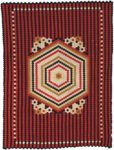 Soldiers and sailors have been stitching masterpieces of the sewing crafts for hundreds of years. It was a longstanding tradition that during lulls in fighting, while prisoners of war or over extended hospital visits, they would hand-stitch quilts, wool work seascapes and embroider their own uniforms. Sailors maintained ships’ sails as part of their duties and therefore had basic sewing skills. Soldiers didn’t have the same job requirement, so if they knew how to sew it was either fortuitous or professional; i.e., they had been tailors in civilian life and were often employed as regimental tailors in the military.
Soldiers and sailors have been stitching masterpieces of the sewing crafts for hundreds of years. It was a longstanding tradition that during lulls in fighting, while prisoners of war or over extended hospital visits, they would hand-stitch quilts, wool work seascapes and embroider their own uniforms. Sailors maintained ships’ sails as part of their duties and therefore had basic sewing skills. Soldiers didn’t have the same job requirement, so if they knew how to sew it was either fortuitous or professional; i.e., they had been tailors in civilian life and were often employed as regimental tailors in the military.
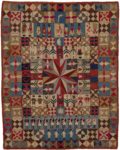 Some of the earliest surviving examples were made in the 18th century using the intarsia technique in which fabric pieces are cut in precise shapes and sewn together so that no seams show. These types of quilts are so difficult to produce that it’s likely they were created by professionals. The imagery is often related to the wars being fought and national identity — comrades, the fatherland, traditional folk tales, etc. The quilts produced in wartime by military men of all levels of stitchcraft experience often used uniform pieces, blankets and random snippets of whatever other textiles they could get their hands on to create geometric designs of dazzling intricacy.
Some of the earliest surviving examples were made in the 18th century using the intarsia technique in which fabric pieces are cut in precise shapes and sewn together so that no seams show. These types of quilts are so difficult to produce that it’s likely they were created by professionals. The imagery is often related to the wars being fought and national identity — comrades, the fatherland, traditional folk tales, etc. The quilts produced in wartime by military men of all levels of stitchcraft experience often used uniform pieces, blankets and random snippets of whatever other textiles they could get their hands on to create geometric designs of dazzling intricacy.
The American Folk Art Museum in New York is putting on the first US exhibition of quilts made by fighting men in wartime from uniform fabric. Most of the quilts on view in the War and Pieced exhibition come from the private collection of Australian quilt expert, historian Dr. Annette Gero. Others are on loan from public and private collections. Many of them have never been publically displayed before.
Immigrant tailors, such as Hungarian-born Michael Zumpf, introduced the intarsia technique into Great Britain. Two masterworks, exhibited to great acclaim in London during the late nineteenth century, feature minutely detailed representations of British military and political leaders, and members of the House of Commons. These elaborate pictorial panels were made using popular etchings of those subjects as templates.
Perhaps the best-known quilts that were made by soldiers and regimental tailors are the complex geometrics fashioned from felted military uniforms. Hand-stitched by nineteenth-century British soldiers, sailors, and regimental tailors during periods of conflict in the Crimea, South Africa, and India, some of these mosaic-like quilts contain as many as twenty-five thousand pieces of fabric. They were once called “convalescent quilts,” it was believed they were made as occupational therapy by wounded soldiers recovering in hospitals. Quilts pieced in simple geometric patterns may indeed have been made in such circumstances, but it is now recognized that the most elaborate quilts were most probably stitched by tailors and soldiers to pass the time and stay out of mischief, to give as gifts to loved ones at home, or were made upon a soldier’s return.
“In the context of war, quiltmaking becomes a life-affirming testament to bravery, loyalty, and an act of redemption for darker human impulses enacted under dire circumstances,” says Stacy C. Hollander[, chief curator of the American Folk Art Museum]. “Memory and experience are fragmented and brilliantly reconstructed through tiny bits of cloth. The uniforms, associated with the best and worst of humanity, are thus transformed into testaments of sanity and beauty, even as the highly organized geometry grants the soldier an illusion of control over the predations of war in which he has both participated and witnessed.”
War and Pieced will run at the American Folk Art Museum from September 6th, 2017, through January 7th, 2018. Next year the exhibition will travel to the International Quilt Study Center & Museum at the University of Lincoln-Nebraska where it will run from the May 25th through September 16th, 2018.
But enough of my yakking. This post is all about the cornucopia of quiltly goodness and there’s so much more bounty to enjoy I had to put it after the jump to keep load times from going insane.
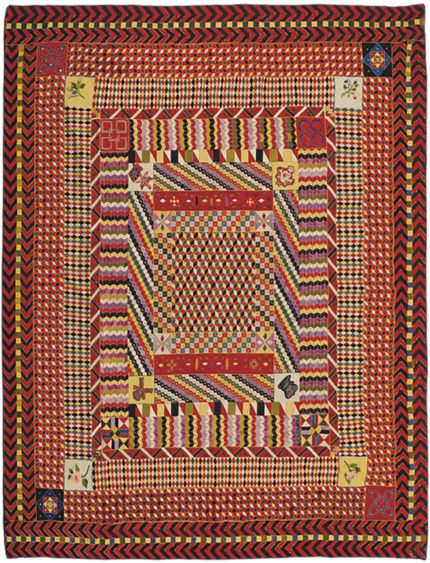
Artist unidentified
India
c. 1890
More than 25,000 tiny tumbling blocks, hexagons, and diamonds, constructed using heavy woollens from military uniforms, with metallic thread and sequins; hand-embroidered and hand-embellished
95 x 76″
Laura Fisher’s Fisher Heritage, New York City.
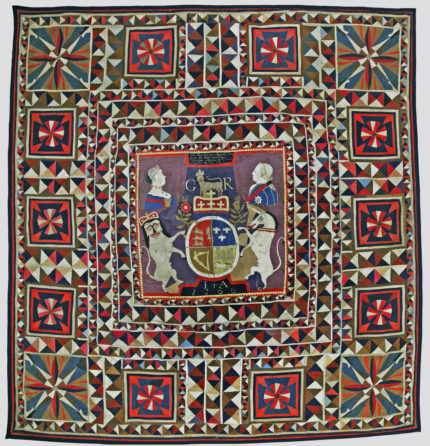
Artist unidentified
United Kingdom or Germany
Dated 1766
Wool, possibly from military uniforms, with embroidery thread; intarsia, hand-appliquéd and hand embroidered
106 x 100″
Collection Sevenoaks Museum, Kent County Council, United Kingdom
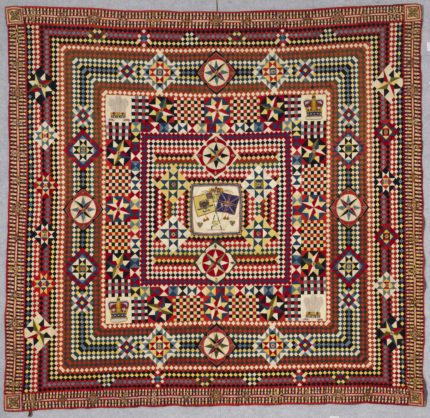
Artist unidentified
India
c. 1855–1875
Wool from military uniforms, with beads; hand-applied beadwork, layered-appliqué border
82 x 88″
The Annette Gero Collection
Photo by Tim Connolly, Shoot Studios
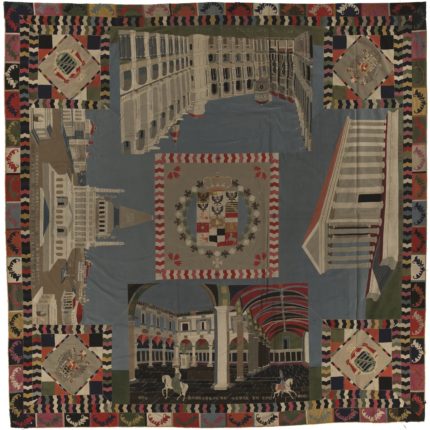
Artist unidentified
Prussia or Austria
1846–1851
Wool, with embroidery thread; intarsia, hand-appliquéd and hand-embroidered
120 x 120″
International Quilt Study Center & Museum, University of Nebraska-Lincoln (2011.068.0001)
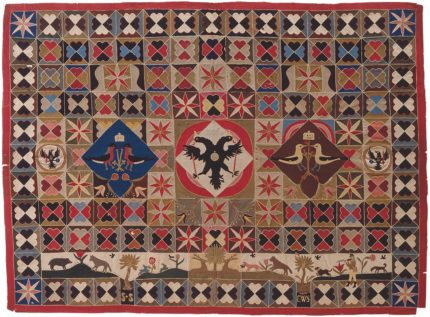
Samuel Sadlowski (dates unknown)
Prussia or Silesia
Dated 1806
Wool from military uniforms, with embroidery thread; intarsia, hand-appliquéd and hand-embroidered
50 x 69″
The Annette Gero Collection
Photo by Tim Connolly, Shoot Studios
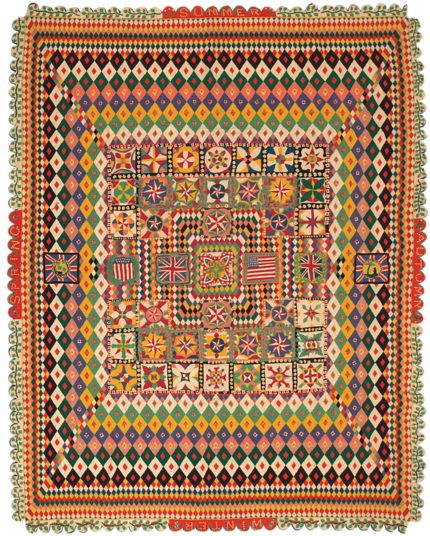
Artist unidentified
Region unknown
Late nineteenth century
Wool felt, probably from military uniforms, with embroidery thread; hand-appliquéd and hand embroidered
90 x 70″
Laura Fisher’s Fisher Heritage, New York City
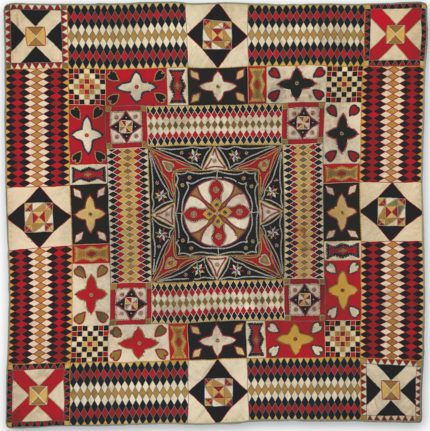
India
c. 1860–1870
Wool, with beads; inlaid, hand-appliquéd, hand-applied beadwork
63 x 63″
The Annette Gero Collection
Photo by Tim Connolly, Shoot Studios
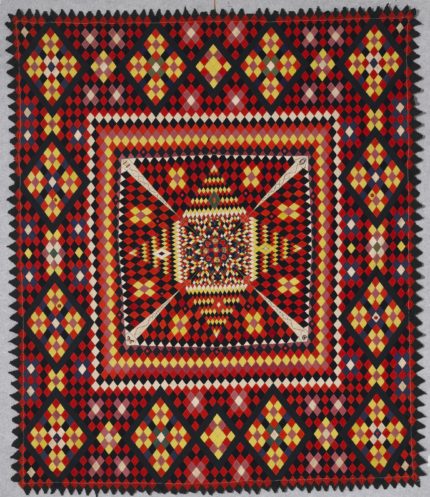
Artist unidentified
South Africa or United Kingdom
Late nineteenth century
Wool from military uniforms, with embroidery thread; hand-embroidered, pointed and pinked edges
88 x 85″
The Annette Gero Collection
Photo by Tim Connolly, Shoot Studios
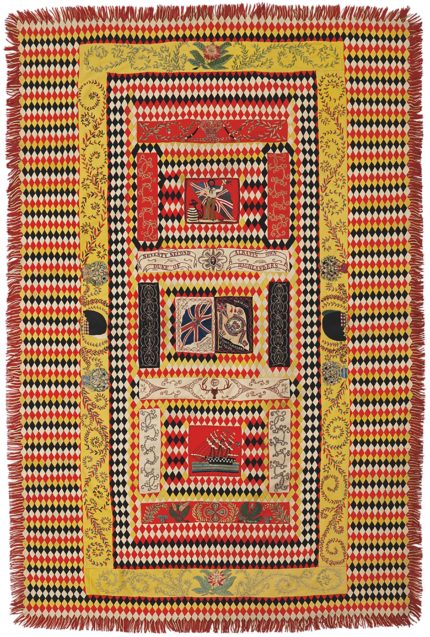
Sergeant Malcolm MacLeod (dates unknown)
India
c. 1865
Wool, mostly from military uniforms, with embroidery thread; inlaid, hand-embroidered
95 x 63″
The Annette Gero Collection
Photo by Tim Connolly, Shoot Studios
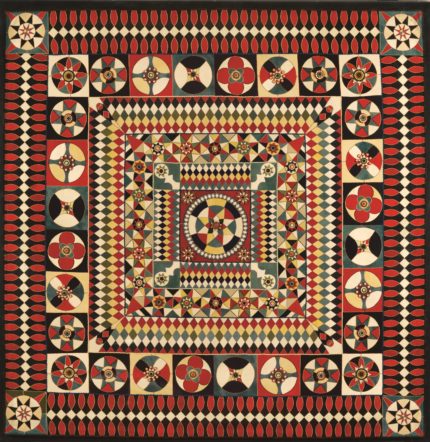
Artist unidentified
Probably India
c. 1850–1880
Wool, probably from military uniforms, with embroidery thread, rickrack, and velvet binding; inlaid,
layered-appliqué, hand-embroidered
67 x 66″
Collection American Folk Art Museum, New York
Gift of Altria Group, Inc., 2008.9.1
Photo by Gavin Ashworth
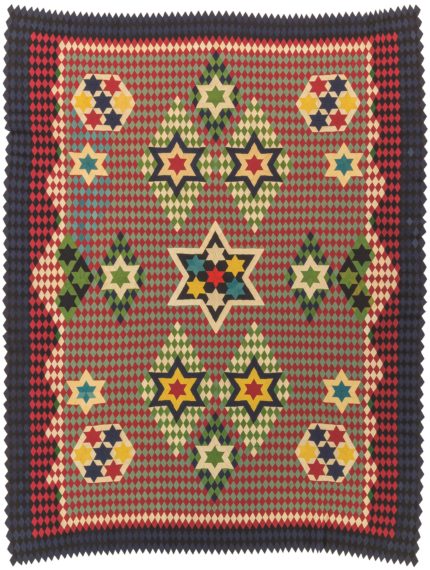
Jewett W. Curtis (1847–1927)
United States
1880–1890
Wool
90 x 70″
International Quilt Study Center & Museum,
University of Nebraska-Lincoln (2016.033.0001)
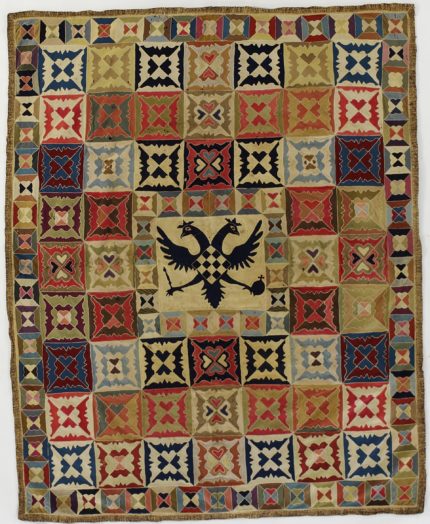
Artist unidentified
Region unknown, possibly Prussia
Late eighteenth/early nineteenth century
Wool, probably from military uniforms; Silesian pieced
69 x 55″
The Annette Gero Collection
Photo by Tim Connolly, Shoot Studios